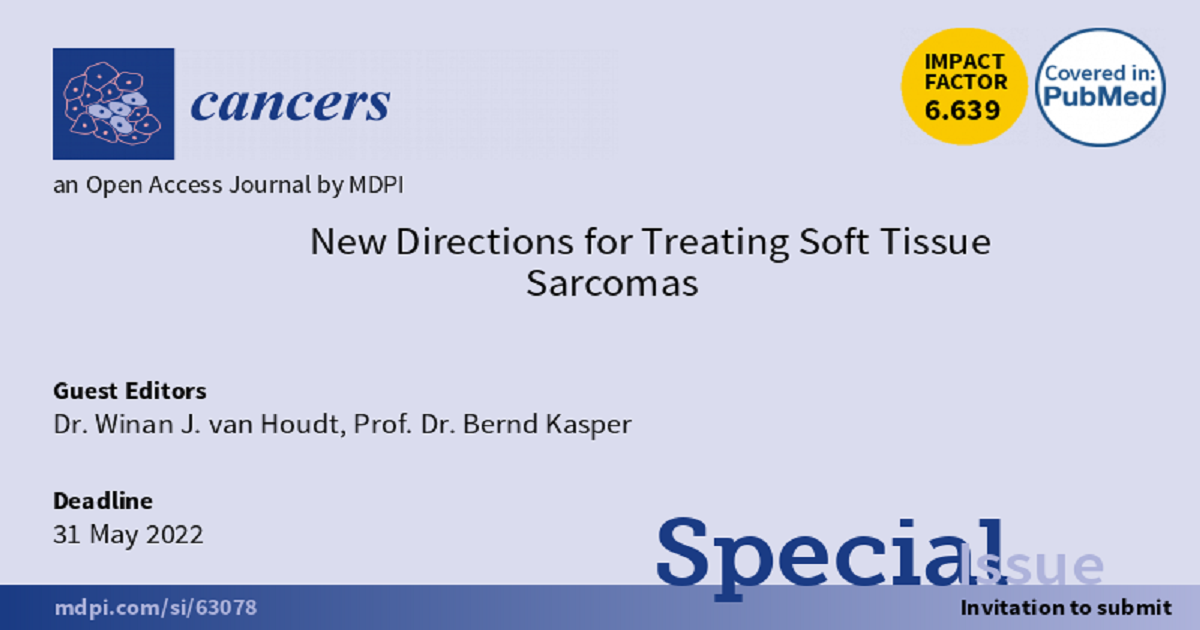New Directions for Treating Soft Tissue Sarcomas
A special issue of Cancers (ISSN 2072-6694). This special issue belongs to the section "Cancer Therapy".
Deadline for manuscript submissions: closed (31 May 2022) | Viewed by 65278

Special Issue Editors
Interests: soft tissue sarcoma; neo-adjuvant treatment for soft tissue sarcoma; translational research; retroperitoneal sarcoma; gastrointestinal stromal cell tumor; desmoid tumors; melanoma; cutaneous squamous cell carcinoma; surgical oncology
Interests: bone and soft tissue sarcomas; gastrointestinal stromal tumors; desmoid tumors; translational research; clinical trials; drug development; medical oncology
Special Issue Information
Dear Colleagues,
In recent decades, there have been several developments in treatment strategies for soft tissue sarcomas (STS) to improve patient outcomes. Currently, there is more insight into the differences in biological behavior and molecular background between the different sarcoma histotypes leading to more focused treatment strategies for specific subtypes. The centralization of sarcoma care and more (international) collaboration in sarcoma research also seem to improve the quality of care.
However, given the heterogeneity of the disease and the rarity of the different subtypes, setting up clinical trials for STS remains challenging. Furthermore, there have been no major breakthroughs with new targeted agents or immuno-oncology strategies when compared to other cancer types. To further improve cure and care for sarcoma patients, this Special Issue will highlight new research directions and multi-disciplinary treatment strategies for patients with STS, in primary, recurrent, and metastatic settings.
Dr. Winan J. van Houdt
Prof. Dr. Bernd Kasper
Guest Editors
Manuscript Submission Information
Manuscripts should be submitted online at www.mdpi.com by registering and logging in to this website. Once you are registered, click here to go to the submission form. Manuscripts can be submitted until the deadline. All submissions that pass pre-check are peer-reviewed. Accepted papers will be published continuously in the journal (as soon as accepted) and will be listed together on the special issue website. Research articles, review articles as well as communications are invited. For planned papers, a title and short abstract (about 100 words) can be sent to the Editorial Office for announcement on this website.
Submitted manuscripts should not have been published previously, nor be under consideration for publication elsewhere (except conference proceedings papers). All manuscripts are thoroughly refereed through a single-blind peer-review process. A guide for authors and other relevant information for submission of manuscripts is available on the Instructions for Authors page. Cancers is an international peer-reviewed open access semimonthly journal published by MDPI.
Please visit the Instructions for Authors page before submitting a manuscript. The Article Processing Charge (APC) for publication in this open access journal is 2900 CHF (Swiss Francs). Submitted papers should be well formatted and use good English. Authors may use MDPI's English editing service prior to publication or during author revisions.
Keywords
- Diagnosing STS
- Neo-adjuvant strategies for STS
- Response prediction in STS
- Recurrent STS
- Centralization of STS treatment
- Follow up after treatment of primary STS
- Immuno oncology for STS
- New targets for STS
- Quality of life for STS patients
Benefits of Publishing in a Special Issue
- Ease of navigation: Grouping papers by topic helps scholars navigate broad scope journals more efficiently.
- Greater discoverability: Special Issues support the reach and impact of scientific research. Articles in Special Issues are more discoverable and cited more frequently.
- Expansion of research network: Special Issues facilitate connections among authors, fostering scientific collaborations.
- External promotion: Articles in Special Issues are often promoted through the journal's social media, increasing their visibility.
- e-Book format: Special Issues with more than 10 articles can be published as dedicated e-books, ensuring wide and rapid dissemination.
Further information on MDPI's Special Issue polices can be found here.







